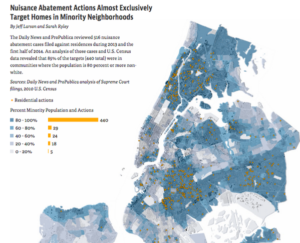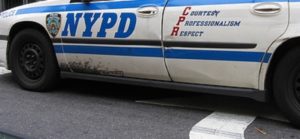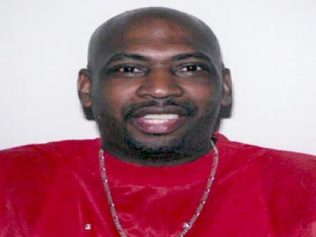In New York City, there is a form of police harassment and state terror employed against poor and working people — and overwhelmingly against Black people. It’s called the “nuisance abatement” law. Get to know it.
Although the concept may be new to many people, it is an obscure law dating back to the 1970s that does not require any proof that a crime has taken place. And this law allows the police to force people out of their homes and to forcibly separate families because one family member may be suspected of a crime, although no charges need be filed. This is what is known as “collective punishment” in communities of color, against innocent people who have committed no crimes — unless it is a crime to be Black and to live in New York, which apparently is the case.
A New York Daily News–ProPublica exposé provides the details of the unsavory and unsettling police state that criminalizes and destroys so many innocent lives. Originally used by the police to clamp down on the sex industry in Times Square, it is an understatement to say that nuisance abatement has been expanded to encompass residences and apartments, bodegas and corner stores. Moreover, this was ramping up even as crime decreased in the city and reached all-time lows. Of the 1,000 such cases filed by the New York Police Department each year, almost half are against residences, according to the Daily News–ProPublica report.
The investigation examined 516 residential nuisance abatement actions filed in state court between January 1, 2013 and June 30, 2014, as well as the related criminal cases of hundreds of people who were evicted from their homes as a result. In the 337 cases where an outcome could be determined, three-quarters of the tenants and homeowners lost or had vacated their homes. Further, 173 of those who were thrown out of their homes or evicted were not convicted of a crime, and 44 were not criminally prosecuted at all. In at least 74 cases, people who were subjected to such actions had agreed to a warrantless search of their premises, sometimes in perpetuity. In addition, some people agreed to automatically give up their lease if merely accused of an offense in the future.
Nuisance abatement is, on the whole, not a punishment designed for white people, as 9 of every 10 communities subjected to the torturous actions were neighborhoods of color. Of the 217 people whose race was identified — out of the 297 people barred from living in their homes — only five were white. Judges were complicit, backing up the cops 75 percent of the time and signing off on the removal of people from their homes.
The toll taken on everyday people by this insidious policy is decisive and devastating:
A man was prohibited from living in his family home and from his young daughter over gambling allegations that were dismissed in criminal court. A diabetic man said he was forced to sleep on subways and stoops for a month after being served with a nuisance abatement action over low-level drug charges that also never led to a conviction. Meanwhile, his elderly mother was left with no one to care for her.
The report notes that because the nuisance abatement action is a civil matter separate from the underlying so-called criminal activity the police allege, the burden of proof is lower than in a criminal matter. And yet, people lose their homes because of suspected crimes they have not committed, and the damage is done even when they have been cleared of any wrongdoing. But that is not the point of the law.
“The law does not require criminal conviction, does not require [a] particular disposition of a criminal case, does not even require an arrest of anyone,” Lawrence Byrne, NYPD’s Deputy Commissioner of Legal Matters told the Daily News last year. “You have to remember, it’s an action about a place. It’s not about people,” said Assistant Commissioner Robert Messner, head of the NYPD’s Civil Enforcement Unit.

As for a nuisance abatement action, while officials in other cities cannot initiate one before giving the landlord an opportunity to solve the problem, and involving all parties in a court process, things are different in New York. The NYPD makes an emergency appeal to a civil judge in the absence of the landlord or tenant, with allegations of dangers posed by drug dealing, gambling or some other activity. The police ask permission to lock residents out of their homes until the situation is resolved, with “temporary closing orders” for an “ongoing illegal manner,” and that the “public health, safety and welfare require immediate abatement of the public nuisance.” Affidavits that describe three instances of an offense during the course of a year — often based solely on confidential informants or undercover officers — are enough to send Black families out into the streets. In 17 nuisance abatement actions against residences and 64 cases against businesses, there were no documented arrests.
In 1995, Bratton celebrated nuisance abatement actions as “probably the most powerful civil tool available to the police” under broken windows policing, allowing officers to “sweep down on a location and close it without warning.” And as the Daily News and ProPublica revealed, since that time the city has witnessed a quintupling in the number of nuisance abatement actions filed each year. Moreover, while Bratton has altered other elements of the NYPD quality-of-life regime, nuisance abatements have continued, and that is the real crime. And one must wonder why he is still the head of the NYPD, and why this outrageous practice was not eliminated yesterday.



